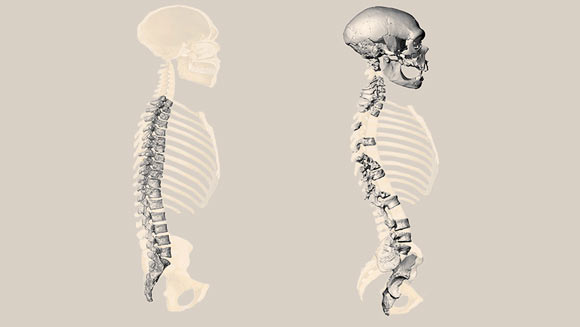19th and early 20th century postural reconstructions of Neanderthals, and particularly the extensive one of the partial skeleton of an elderly male Neanderthal from the site of La Chapelle-aux-Saints in France, created persistent images of these archaic humans as primitive and incompletely erect. Now a team of researchers at the University of Zurich has completed a 3D virtual reconstruction of the pelvis and spine of the La Chapelle-aux-Saints Neanderthal, and found that he, and by extension other Neanderthals, had a fully upright — and human — posture.

A reconstruction of a Neanderthal man. Image credit: Neanderthal Museum.
Fully upright and balanced posture is one of the hallmarks of humanity, and it has long been seen as present among all members of the genus Homo.
However, recent analyses of Neanderthal vertebrae have concluded that these archaic humans lacked fully developed S-shaped spine.
“Our virtual reconstruction of the La Chapelle-aux-Saints skeleton delivers evidence to the contrary,” said team member Dr. Martin Haeusler, a researcher in the Institute of Evolutionary Medicine at the University of Zurich.
Dr. Haeusler and co-authors were able to show that Neanderthals had a curved lumbar region and neck — just like anatomically modern humans.
“When reconstructing the pelvis, we discovered that the sacrum was positioned in the same way as in modern humans,” they explained.
“This led us to conclude that Neanderthals possessed a lumbar region with a well-developed curvature.”
“By putting together the individual lumbar and cervical vertebrae, we were able to discern that the spinal curvature was even more pronounced.”
“The very close contact between the spinous processes — the bony projections off the back of each vertebra — became clear, as did the prominent wear marks that were in part caused by the curvature of the spine.”

Previous (left) and new reconstructions of the Neanderthal spine. Image credit: Haeusler et al / Been et al.
The scientists also found wear marks in the hip joint of the La Chapelle-aux-Saints skeleton.
“The stress on the hip joint and the position of the pelvis is no different than ours,” Dr. Haeusler said.
“This finding is also supported by analyses of other Neanderthal skeletons with sufficient remnants of vertebrae and pelvic bones.”
“On the whole, there is hardly any evidence that would point to Neanderthals having a fundamentally different anatomy,” he added.
“Now is the time to recognize the basic similarities between Neanderthals and modern humans and to switch the focus to the subtle biological and behavioral changes that occurred in humans in the late Pleistocene.”
The findings appear in the Proceedings of the National Academy of Sciences.
_____
Martin Haeusler et al. Morphology, pathology, and the vertebral posture of the La Chapelle-aux-Saints Neandertal. PNAS, published online February 25, 2019; doi: 10.1073/pnas.1820745116







